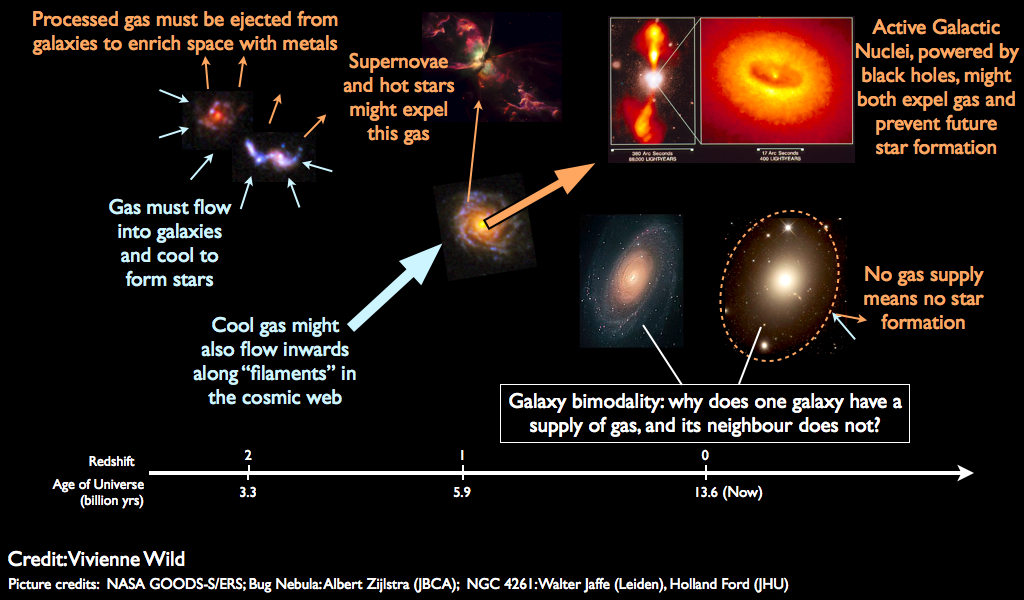If you are a professional astronomer, you might prefer the Research Notes section.
Galaxies like our own Milky Way are conglomerations of billions of stars mixed together with gas, dust and dark matter. When we look at the images of galaxies in the local Universe we see that galaxies come in two main types. The first type is the impressive grand design spiral, with spiral arms extending outwards from a central bulge. This type of galaxy is generally blue in colour, which means that they are full of young, hot stars. Therefore we diagnose that they are currently in the process of converting their gas into stars. The second type of galaxy is the elliptical, a rugby-ball shaped galaxy which is generally red in colour. The red colour arises because the stars are predominantly old and cool, from which we know that the galaxy has stopped converting gas into stars. These two types of galaxies form the main arms of the Hubble sequence or "Tuning fork".
My research (summarised in the Figure below) is concerned with why we see these two types of galaxies. What makes one galaxy stop forming stars, when its neighbour still has a plentiful supply of gas which it is converting into stars? The answer to this question is crucial in building a complete picture of how galaxies were first formed, and how they have evolved into the grand systems that we see around us in the local Universe today.

In the last decade, astronomers have made enormous progress in measuring the properties of local and distant galaxies: their mass, age, chemical composition, and so on. The galaxy surveys that I have worked with are the 2dF, SDSS (visit the Skyserver for some fun things to do if you are a budding amateur astronomer), VVDS and Deep2. I am currently a member of the high redshift Hubble Space Telescope CANDELS survey and the low redshift, integral field spectroscopic ( IFS) survey CALIFA
One important requirement for understanding the physics behind galaxy evolution lies in understanding the gas and how it is converted into stars. And unfortunately we know very little about the gas around the galaxies, especially at high redshifts. One way of studying the physical properties of gas in the Universe is through measuring the absorption it causes to light from a bright background light source, like a quasar. These "quasar absorption line systems" (QSOALs) can tell us about the amount of gas, its metallicity, ionisation, velocity dispersion and velocity relative to any nearby galaxies. Part of my PhD involved studying these QSOALs, and I have recently written papers with collaborators in the US on their properties. Unfortunately it's very difficult to link what we see in absorption to the galaxies that we see in the sky. Ideally we would like to understand the relation between gas around galaxies and the galaxy properties. With Tim Heckman at JHU I recently obtained data from the Cosmic Origins Spectrograph on the Hubble Space Telescope to study the difference in the gas around normal galaxies and galaxies that have recently shut-down their star formation.
As well as studying the gas around galaxies, it is equally important to understand the gas processing that occurs within galaxies, and the mechanisms for ejection of gas from galaxies. Once gas reaches the galaxy, one popular theory suggests that supermassive black holes (SMBHs) accreting matter (the cause behind an Active Galactic Nuclei) at the centre of the galaxies might heat the gas, or blow it away, preventing the galaxy from forming more stars. The fuelling of such an event is often associated with the merger of two galaxies, allowing the gas to be funnelled quickly into the centre of the galaxy. However, recently I found that black holes don't actually appear to grow at the time of the burst of starformation that is likely triggered by a merger, but several hundred million years afterwards. This suggests some other mechanism, such as supernovae explosions, might be preventing the gas from reaching the central black hole. You can read more here.
This leads to my current primary area of research: understanding the importance of mergers between galaxies for trigerring star formation, and whether the physical mechanisms by which the gas is converted into stars in mergers is substantially different from "normal" star formation in galaxies.
If you want to read more details about my research, check the Research Notes section, or my publication list.


